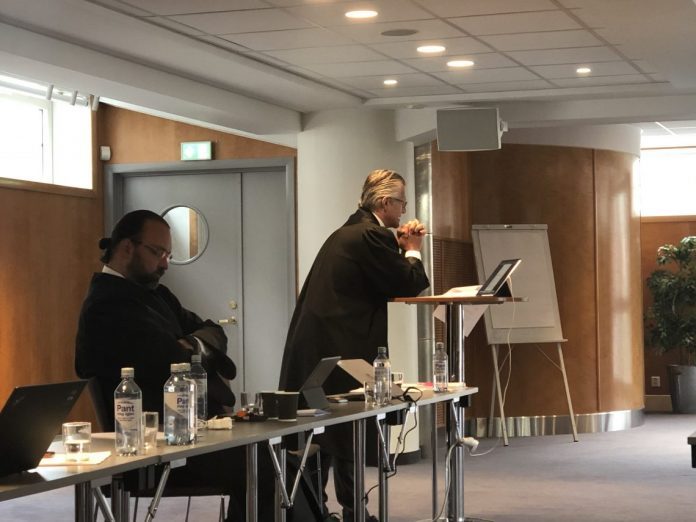Hav Lines lawyer Trond Hatland is attacking former Norwegian minister Harald Tom Nesvik on the opening day of the “Norwegian Gannet” trial.
The Bergen District Court started the main hearing on Monday morning in the case between Hav Line and the Norwegian government. The plaintiff is the Hav Line group, represented by attorney Trond Hatland, partner in the law firm Thommessen.
The focal point of the case is “Norwegian Gannet”, the much-talked-about combination of a wellboats, cargo boats and transport ship, which transports salmon from Norway to Denmark.
In a normal salmon harvesting process, between two and five percent of the fish are so-called “production fish”, fish with visible damage and wounds. These fish are not allowed to be exported until their errors are corrected – in Norway. However, before the ship was put into operation, Hav Line received a derogation from the Norwegian Food Safety Authority and the Ministry of Fisheries. The government has subsequently rejected an extension of an exemption for export of production fish, which is the basis of the current lawsuit.
“The government has shown great creativity to stop Hav Line,” Hatland says in his opening speech in court Monday.
“The government has stepped in and amended the regulations. Fortunately, it is very, very rare for this to happen. But it has happened here – to stop Hav Line.”
“The judgement was made exclusively by the former Norwegian Minister of Fisheries Harald Tom Nesvik. He has gone up against decisions from both the Food Safety Authority and the Ministry,” he continues.
Public support
Hatland points out that “Norwegian Gannet” achieves environmental benefits, including by saving the roads for extensive trailer transport and rather lifting the fish transport to sea.
“Hav Line has received NOK 30 million (EUR 2.6 million) in public funding in support. This is a waste of money if Hav Line has to close down,” he believes.
Hatland says that during 2019 the harvesting vessel delivered 24,600 tonnes of salmon and trout, and 7,320 tonnes until April 2020. He also emphasises that “Norwegian Gannet” was used for rescue harvests during the algae bloom in northern Norway last summer.
“The governments’s main concern is that there is a risk that the reputation of “Norwegian salmon” may be damaged.
Fish farmer Kjell Haugland invented the “Hav Line method” and established the company in 2013. Trient, owned by the Sekkingstad family, later entered the owner’s side. The Haugland Group and Sekkingstad have guaranteed 15,000 tonnes of salmon annually for Hav Line.
Hav Line then obtained approvals from the Norwegian Food Safety Authority and the Ministry of Fisheries, entered into financing and construction contracts. In the fall of 2018, the boat was delivered from the shipyard in Spain.
Reversed decision
“Only one event is new. We got Nesvik as Minister of Fisheries. He doesn’t like production fish abroad,” Hatland says.
Former Minister of Fisheries Harald Tom Nesvik has been called to testify and will explain himself later.
The reversal of the decision from the Ministry came on December 3, 2018, a month after “Norwegian Gannet” was handed over to the shipping company.
Hatland further notes that Hav Line’s reception terminal in Hirtshals is defined as “customs warehouse”. This means that the fish are not formally considered to be exported. There, the production fish is sorted before being returned to Norway.
“The quality regulation is made for a different time than now. At that time, the fish was exported around and unfiltered,” he says.
“There is no one else in Norway today, there are no Norwegian processors, who deliver better quality,” says Hatland, highlighting, among other things, the superior freshness that the harvesting vessel guarantees. From harvesting fish collected in the southern or western Norway, the fish arrive in Denmark within eight or 20 hours respectively.
Protectionism
“It is pure protectionism, as some have stated. Norwegian jobs are all about this.”
Read also: Exposed to Norwegian incapacity, unfair obstruction, protectionism & miscarriage of justice”
Hatland also points out that not all Norwegian processors have approval for rectification.
“You allow the transit of fish to our neighbouring countries, but not to Hav Line,” says Hatland, pointing out that there is a considerable transit of fresh salmon and trout by railroad from Narvik through Sweden to Alnabru near Oslo.
“Our argument is that this can be compared to Hav Line’s customs warehouse in Denmark.”
Government Attorney Torje Sunde represents the Ministry of Trade and Fisheries in the case against Hav Line. He states in court that it is not documented that the mentioned fish, which is sent through Sweden, is unsorted production fish.
However, Hatland is aware that it is not up to Norwegians to evaluate the salmon’s reputation abroad.
“The salmon’s reputation abroad is assessed by others than us. The government cannot have any defining power for what is a good reputation,” he says.
“It is not government control that solves this, but the market’s perception determines it.”

